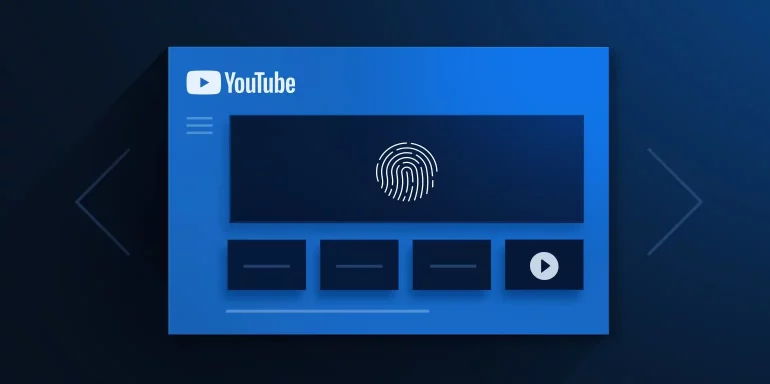The YouTube Masthead is living proof that marketers are still taking advantage of outbound marketing tactics.
A YouTube Masthead is a digital billboard placed on YouTube’s homepage for 24 hours, reaching roughly 60 million people (YouTube receives 1.8 billion users/month). The homepage ad can have multiple videos, CTAs, and social media sharing buttons.
Since the ad is placed in front of a large non-targeted audience, this ad type is best used by companies who want to maximize their brand exposure and have the budget to do it.
By the end of the article, you’ll know whether a YouTube Masthead ad is something your business can benefit from, how much it can cost, how it performs compared to TV ads, and what companies can expect to gain from this ad type.
How is the YouTube Masthead different than other ad types?
The YouTube Masthead is a homepage ad that doesn’t appear layered on other videos, nor in the corner of the page. It only appears on the network’s homepage and cannot target users based on their search history.
In comparison, these other 4 YouTube Ad types allow you to target viewers based on demographics, interest, life events, and in-market audiences:
- YouTube Overlay Ads (appear at the bottom of a video)
- TrueView Ads (skippable video ads that appear at the beginning of the video the user initially clicked on)
- Pre-Roll Ads (non-skippable video ads that appear at the beginning of the video)
- YouTube Display Advertising (a banner ad to the side or the bottom of a video)
The YouTube Masthead ad doesn’t have many of the same targeting options that the above ad types have (demographics, interests, life events, etc.). You can only choose the country where the ad . Plus, the ads mentioned above are positioned differently and have different specs and looser policies.
Since your ad will be shown to millions of viewers, YouTube has a few extra rules you need to follow. For example, if you want to advertise your gambling business, you must complete an application with Google Ads.
What devices are YouTube Mastheads shown?
The YouTube Masthead is shown on both desktop and mobile devices. However, Android and iOS display the Masthead differently:
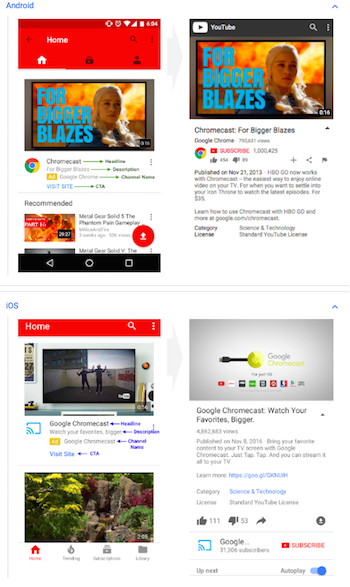
The mobile Masthead is a homepage ad as well. There are no other differences with targeting, and unfortunately, YouTube hasn’t provided statistics on the number of Android users vs. IOS.
What are the ad specs for each device?
According to Google support, the YouTube Masthead desktop version has the following technical specifications:
- Video cannot be private
- The auto-play shouldn’t be longer than 30 seconds
- 0-second autoplay is not allowed
- Video thumbnail will be shown once autoplay finishes
- For best results, use videos with a 16:9 aspect ratio whenever possible
- The form and color of the CTA button cannot be changed
- Thumbnails can be cropped on the left and right
These are only a high-level summary of the key YouTube Masthead ad specs that will have the biggest impact on the way your YouTube homepage ad will look. For full details, visit this Google support page.
The YouTube Masthead ad comes in two versions: widescreen and 16:9 ratio. First, the widescreen version:
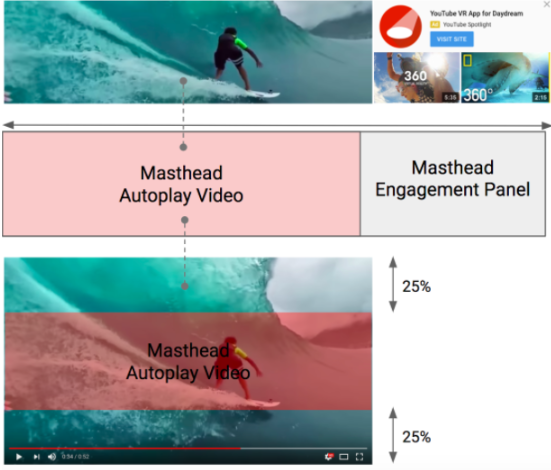
And now the 16:9 ratio version:
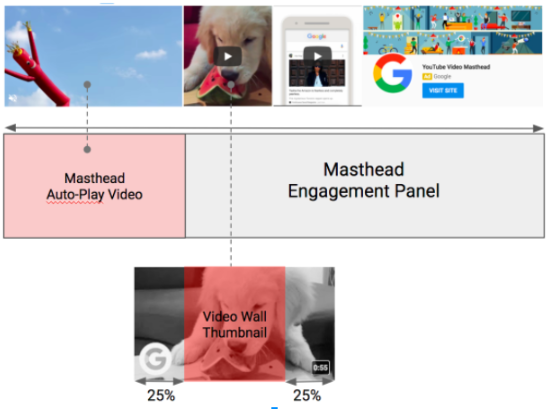
To get a better idea of what your video will look like, use YouTube’s preview too.
What do the best Mastheads have in common?
While Masthead ads are not targeted, there are still trends you should look at (like who uses YouTube, age groups, what types of video are trending, etc.). Advertising a new treatment for arthritis on YouTube might not be the smartest decision, as most people over 50 don’t watch YouTube videos.
The best Masthead ads capture the user’s attention immediately, are entertaining, and stir the viewer’s curiosity.
Consider these top tips with your Masthead ads:
1. Be clever but keep it simple
A boring ad will get ignored, but if your clever joke is a bit hard to understand, you might leave a large chunk of your audience wondering what they just watched.
2. Brevity is the soul of wit
The famous words of Shakespeare apply to this day. Keep it short and cut straight to the point. The more compressed your message, the more powerful it will be.
3. Give the viewer different options
When you run a YouTube homepage ad, simply including a CTA might ignore users that are not ready to buy or view your product yet.
Instead, experiment with the features available. Give them the option to see more related videos, share on social media, or click your photo gallery.
YouTube Masthead examples
YouTube likes to promote its new offering YouTube TV so you may see a banner for that more often as it grows in popularity. When the platform is not pushing its own service, other big name, brands take the spotlight, like Rice Krispies.
In the video ad, a group of children create a “symphony” using the sounds of pouring cereal, spoon drumsticks, and the famous crunch of every bite. To the right, you will notice a link to their homepage and related Rice Krispies videos as well:

Since YouTube is a platform that’s heavily focused on entertainment, it makes sense for giants like Disney to promote their latest movies using the platform as a billboard:
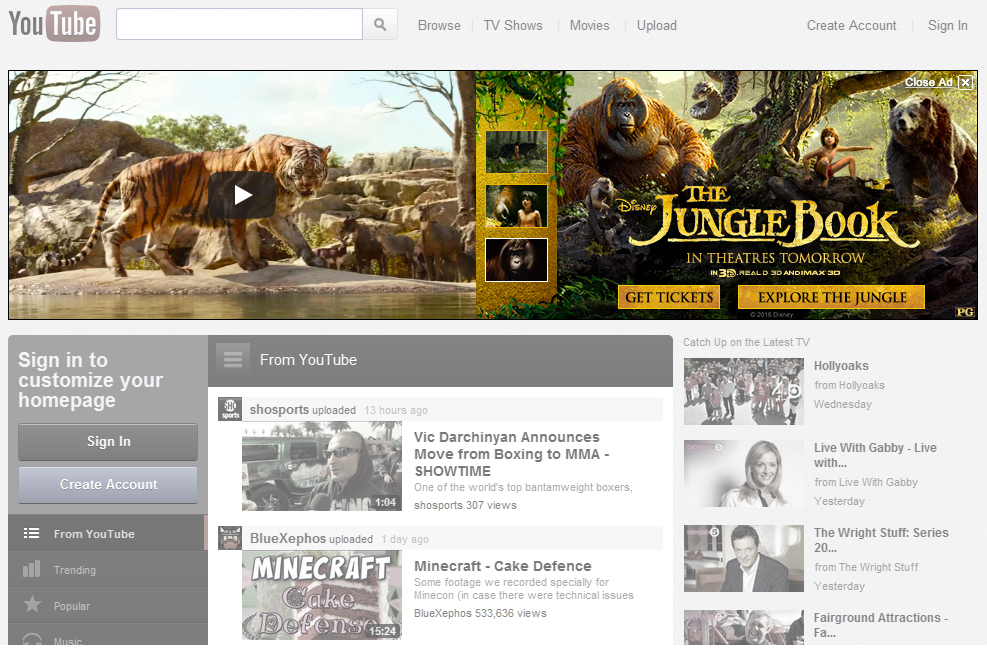
Disney’s Masthead ad promoted “The Jungle Book,” and it takes advantage of several features:
- Multiple videos on the right side to choose from after you’ve finished watching the first video
- Interactive media
- Two call-to-action buttons (“Get Tickets” and “Explore the Jungle”)
Tesco, a retailer in the UK, took advantage of the Star Wars craze to sell fans personalized notebooks:
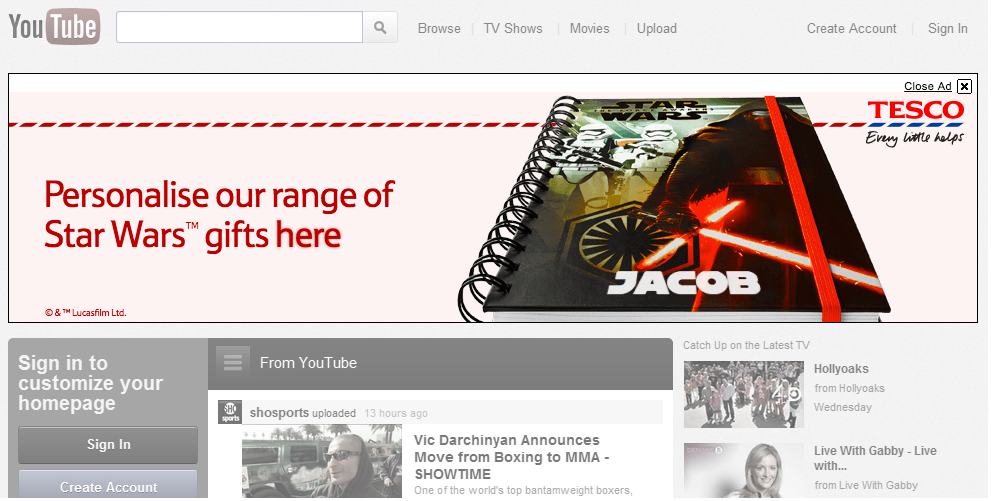
The Jurassic World Masthead shown below was promoted in France and took advantage of a series of features, including:
- Search bar
- More videos link
- Photo gallery
- Social sharing button
- CTA button to buy tickets

Big brands are the primarily the ones that advertise on the YouTube homepage. That is because a large audience comes at a high price, and there aren’t many companies out there that have the budget for it. Smaller companies are more focused on getting clients instead of spreading the word about their company, which means they must wait longer for their branding efforts to pay off.
How much do they cost and how does the pricing model work?
According to Adweek, placement will cost you a minimum of $300,000 to $400,000 (depending on the country you’re targeting), and it can climb up to almost $1 million on Super Bowl Sunday.
However, keep in mind that these are all estimates, and it’s best to contact the YouTube team for accurate pricing.
What the statistics say
Google partnered with Compete to determine the impact of YouTube homepage ads had on brand searches and site visits. According to their findings, users who were exposed to a YouTube Masthead were four times more likely to visit the advertiser’s website, search for their brand, or engage with even more of their videos.
The study also revealed that advertisers from the entertainment industry experienced a 340% increase in website visits, which shows that even though the ads weren’t targeted, knowing a bit about the user base of the platform can go a long way.
Compared to TV ads…
An eye-tracking study conducted by Google and Tobii Pro Insights reveals that social media ads receive more attention from the viewer when compared with TV ads. But there’s a catch — the longer the commercial, the higher the chance of the viewer clicking away.
The study also revealed that TV advertising is not dead, as around 50% of the participants chose to watch the ads. The problem is the cost. Advertisers pay less for social media ads, even those that target a larger audience.
Should your brand use the Masthead?
With as many as 60 million people visiting YouTube each day, the potential reach is huge with Masthead ads. That reach doesn’t come without a steep price, and you can expect to pay a premium for this ad type.
For large brands with the budget to do so, it’s a great opportunity. For small to medium-sized businesses, however, the Masthead is likely out of reach and likely not as cost-effective as other advertising options that offer deeper targeting options (like demographics, interest targeting, etc.).
If your brand is in the latter category, take a look at the digital advertising reference guide. Inside, you’ll discover the top platforms brands use to target their audience, see real-life ad examples, and how to optimize your visitor’s landing page ad experience. You can also sign up today for a 14-day trial and see the impact Instapage has on your campaign results!

Try the world's most advanced landing page platform with a risk-free trial.
